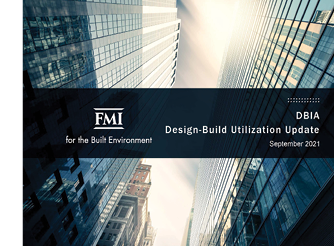
When they first looked at design-build utilization in 2018, researchers at North Carolina-based management consultant FMI confirmed what many in the industry knew first-hand: the project delivery method was beyond an “alternative process.” The firm’s new market analysis, forecasting 2021-2025 project activity and prepared for the Design-Build Institute of America (DBIA), underscores the initial assessment and traces the contracting method’s continued growth despite pandemic disruptions.
FMI researchers have measured design-build contract value for nonresidential building plus transportation and environmental infrastructure work across nine U.S. Census regions. They project the delivery method to yield a compound annual growth rate of 7.6 percent over the next five years, reaching $400 billion in 2025.
Design-build has seen increased usage in all sectors and regions of the United States, DBIA affirms, and the industry has also witnessed extraordinary project outcomes and innovation. The FMI Design-Build Market Update report provides detailed geographic and sector data, including market analysis and projections. Among highlights:
- Design-build is anticipated to account for as much as 47 percent of construction spending in the assessed segments (Nonresidential, Highway/Street, Transportation and Water/Wastewater) by 2025.
- While national construction put in place spending over the pandemic window saw a decline, design-build project spending saw slight upticks of 1.3 percent in 2020 and an estimated .5 percent increase in 2021.
- Design-build project delivery stands to outperform national construction put in place growth rates by 1.6 percent over the 2021-2025 window, delivering $1.7 trillion in construction in the assessed segments.
- Highway/Street, Education and Manufacturing represent the greatest percentage of design-build construction spending by segment over the 2021-2025 period.
- The Census divisions anticipated to yield the highest annual growth rates in design-build adoption are West South Central (8.8 percent), South Atlantic (8.6 percent) and Middle Atlantic (8.2 percent).
- Spending on design-build projects is anticipated to grow 34 percent overall, with the Water/Wastewater sector showing the highest annual growth (11.1 percent).
- Experience with design-build rates highest across all project delivery methods, with 77 percent of respondents to FMI surveys reporting very good and excellent experiences.
- The ability to fast track, innovate and increase project collaboration/communication are viewed as top design-build method benefits.
“This latest research confirms that as growing numbers of teams use design-build in all sectors, regions and project sizes, their successes are driving growth and innovation,” says DBIA Executive Director Lisa Washington. “Design-build is changing the way America builds. More than ever, as our nation considers the passage of historic infrastructure investment, it’s clear design-build will play a significant role in delivering the most time and cost-efficient projects to our communities. Just when we need it most.”
CONSTRUCTION PUT IN PLACE SPENDING

Design-build method adoption across 12 segments, 2021-2025
Researchers project annual design-build contract activity climbing from $303 billion this year to $405 billion in 2025. SOURCE: FMI Design-Build Utilization Update, September 2021